Entry Database : PDB / ID : 3qt0Title Revealing a steroid receptor ligand as a unique PPARgamma agonist Nuclear receptor coactivator 1 peptide Peroxisome proliferator-activated receptor gamma Keywords / Function / homology Function Domain/homology Component
/ / / / / / / / / / / / / / / / / / / / / / / / / / / / / / / / / / / / / / / / / / / / / / / / / / / / / / / / / / / / / / / / / / / / / / / / / / / / / / / / / / / / / / / / / / / / / / / / / / / / / / / / / / / / / / / / / / / / / / / / / / / / / / / / / / / / / / / / / / / / / / / / / / / / / / / / / / / / / / / / / / Biological species Homo sapiens (human)Method / / / Resolution : 2.496 Å Authors Rong, H. Journal : Cell Res. / Year : 2012Title : Revealing a steroid receptor ligand as a unique PPAR gamma agonist.Authors : Lin, S. / Han, Y. / Shi, Y. / Rong, H. / Zheng, S. / Jin, S. / Lin, S.Y. / Lin, S.C. / Li, Y. History Deposition Feb 22, 2011 Deposition site / Processing site Revision 1.0 Feb 29, 2012 Provider / Type Revision 1.1 Aug 28, 2013 Group Revision 1.2 Feb 21, 2024 Group Data collection / Database references ... Data collection / Database references / Derived calculations / Structure summary Category chem_comp / chem_comp_atom ... chem_comp / chem_comp_atom / chem_comp_bond / database_2 / struct_site Item _chem_comp.pdbx_synonyms / _database_2.pdbx_DOI ... _chem_comp.pdbx_synonyms / _database_2.pdbx_DOI / _database_2.pdbx_database_accession / _struct_site.pdbx_auth_asym_id / _struct_site.pdbx_auth_comp_id / _struct_site.pdbx_auth_seq_id
Show all Show less
 Yorodumi
Yorodumi Open data
Open data Basic information
Basic information Components
Components Keywords
Keywords Function and homology information
Function and homology information Homo sapiens (human)
Homo sapiens (human) X-RAY DIFFRACTION /
X-RAY DIFFRACTION /  SYNCHROTRON /
SYNCHROTRON /  MOLECULAR REPLACEMENT / Resolution: 2.496 Å
MOLECULAR REPLACEMENT / Resolution: 2.496 Å  Authors
Authors Citation
Citation Journal: Cell Res. / Year: 2012
Journal: Cell Res. / Year: 2012 Structure visualization
Structure visualization Molmil
Molmil Jmol/JSmol
Jmol/JSmol Downloads & links
Downloads & links Download
Download 3qt0.cif.gz
3qt0.cif.gz PDBx/mmCIF format
PDBx/mmCIF format pdb3qt0.ent.gz
pdb3qt0.ent.gz PDB format
PDB format 3qt0.json.gz
3qt0.json.gz PDBx/mmJSON format
PDBx/mmJSON format Other downloads
Other downloads 3qt0_validation.pdf.gz
3qt0_validation.pdf.gz wwPDB validaton report
wwPDB validaton report 3qt0_full_validation.pdf.gz
3qt0_full_validation.pdf.gz 3qt0_validation.xml.gz
3qt0_validation.xml.gz 3qt0_validation.cif.gz
3qt0_validation.cif.gz https://data.pdbj.org/pub/pdb/validation_reports/qt/3qt0
https://data.pdbj.org/pub/pdb/validation_reports/qt/3qt0 ftp://data.pdbj.org/pub/pdb/validation_reports/qt/3qt0
ftp://data.pdbj.org/pub/pdb/validation_reports/qt/3qt0 Links
Links Assembly
Assembly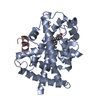
 Components
Components Homo sapiens (human) / Gene: PPARG, NR1C3 / Production host:
Homo sapiens (human) / Gene: PPARG, NR1C3 / Production host: 
 Homo sapiens (human) / Gene: NCOA1, BHLHE74, SRC1 / Production host:
Homo sapiens (human) / Gene: NCOA1, BHLHE74, SRC1 / Production host: 
 X-RAY DIFFRACTION / Number of used crystals: 1
X-RAY DIFFRACTION / Number of used crystals: 1  Sample preparation
Sample preparation SYNCHROTRON / Site:
SYNCHROTRON / Site:  APS
APS  / Beamline: 21-ID-F / Wavelength: 0.9787 Å
/ Beamline: 21-ID-F / Wavelength: 0.9787 Å Processing
Processing MOLECULAR REPLACEMENT / Resolution: 2.496→31.476 Å / SU ML: 0.38 / σ(F): 1.33 / Stereochemistry target values: ML
MOLECULAR REPLACEMENT / Resolution: 2.496→31.476 Å / SU ML: 0.38 / σ(F): 1.33 / Stereochemistry target values: ML Movie
Movie Controller
Controller


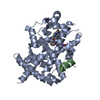
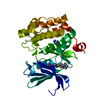

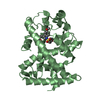

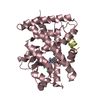

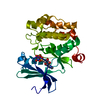


 PDBj
PDBj














